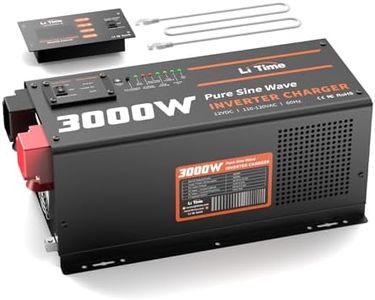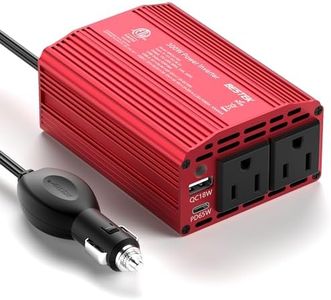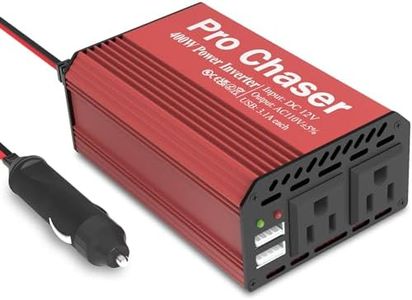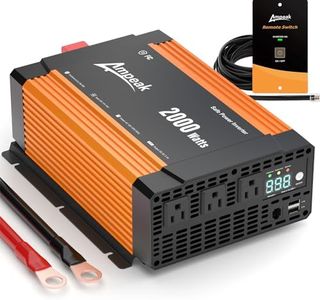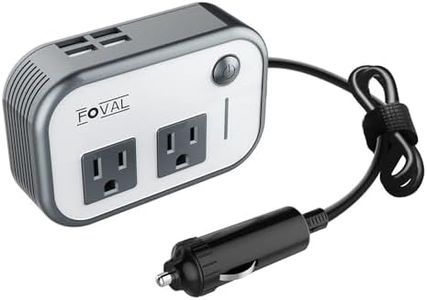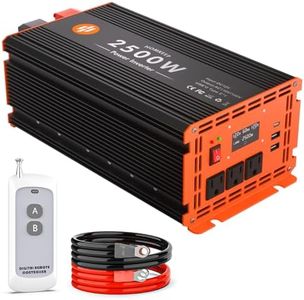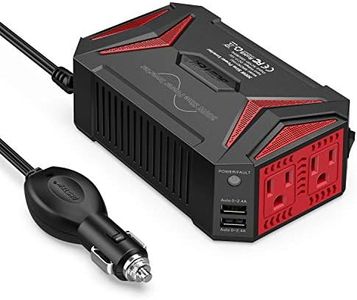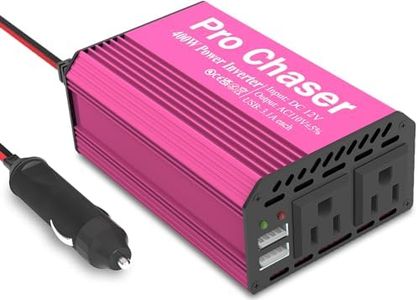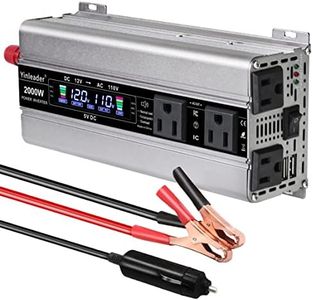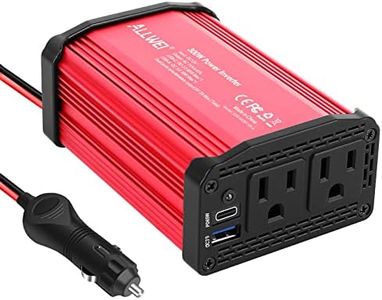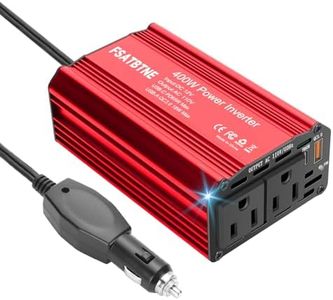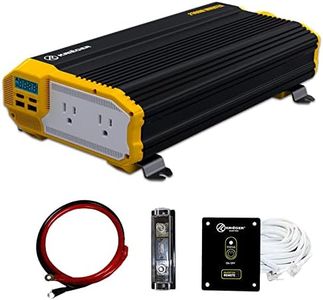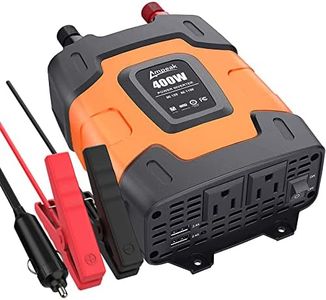10 Best Car Inverters 2025 in the United States
Our technology thoroughly searches through the online shopping world, reviewing hundreds of sites. We then process and analyze this information, updating in real-time to bring you the latest top-rated products. This way, you always get the best and most current options available.

Our Top Picks
Winner
BESTEK 300W Car Power Inverter with 65W USB-C and QC3.0 Ports - 12V DC to 110V AC Converter for Vehicles with Multi-Protection - Red
Most important from
32951 reviews
The BESTEK 300W Car Power Inverter offers a solid combination of functionality and convenience for users needing a reliable power source on the go. With a continuous power output of 300 watts and a peak power of 700 watts, it can handle a variety of devices, making it versatile for multiple uses like charging phones, laptops, and even small appliances such as air pumps and CPAP machines. The inclusion of 2 AC outlets, a 65W USB-C port, and a QC 18W USB-A port allows for simultaneous charging of up to four devices, which is a significant advantage for those with multiple gadgets. The upgraded 65W USB-C port is particularly useful for quickly charging newer laptops and other high-power devices.
Safety features such as built-in fuses, overheating protection, and short circuit protection ensure that both the inverter and your devices are well-protected during use. The intelligent cooling fan is a thoughtful addition that helps manage heat and reduce noise. One of the notable strengths of this inverter is its portability. Weighing only 15.8 ounces and having compact dimensions (2 x 4 x 6 inches), it is easy to carry and ideal for travel, work trips, and camping.
While the inverter provides a good amount of power, it may not be suitable for very high-power devices. Additionally, users must ensure their vehicle's battery can handle the power draw, especially when using multiple high-power devices simultaneously. In summary, the BESTEK 300W Car Power Inverter is a dependable and versatile tool for users who need to charge and power multiple devices on the go, with its compact size, safety features, and powerful outlets being its standout features.
Most important from
32951 reviews
Pro Chaser 400W Power Inverters for Vehicles - DC 12v to 110v AC Car Inverter Converter, 6.2A Dual USB Charging Ports, Dual AC Adapter for Air Compressor Laptops (Red)
Most important from
1267 reviews
The Pro Chaser 400W Power Inverter is a versatile and portable option for those who need to power various devices on the go. With a continuous power output of 400 watts and a peak power of 800 watts, it can efficiently handle small to medium-sized electronic devices. This inverter includes two 110V AC power sockets and two 6.2A USB ports, making it convenient for charging multiple devices like laptops, tablets, and smartphones simultaneously.
The compact size and lightweight design (weighing only 14.1 ounces) make it easy to carry and ideal for road trips, camping, and vacations. The 30-inch cord provides flexibility to place the inverter in the back seat or other areas of the vehicle. Safety is well-addressed through built-in protections against short-circuits, overloads, low and high voltages, and overheating. The inverter automatically turns on its cooling fan when the internal temperature reaches 113F, ensuring safe operation.
The durable metal housing adds an extra layer of protection from physical impacts. However, one downside is that it draws power from the cigarette lighter socket, which may not support higher power requirements for more demanding equipment. Additionally, while it is compact, the need to keep it connected to the cigarette lighter socket might limit placement options within the vehicle. Despite these minor drawbacks, it’s a solid choice for those needing dependable power on the go with added safety features and ease of use.
Most important from
1267 reviews
Ampeak 2000W Power Inverter Conversion Efficiency 89.37% Modified Sine Inverter 12V DC to 120V AC Built-in 40A*10pcs Fuse 3AC Outlets Dual 5V/3.1A USB Ports 12V Inverter for Vehicles
Most important from
898 reviews
The Ampeak 2000W Power Inverter offers a robust power output with its 2000 watts continuous and 4000 watts peak power, making it suitable for a variety of vehicle applications. Its 89.37% conversion efficiency is exceptional compared to many competitors, which means more efficient energy use and longer device life. The inverter operates on a 12V input voltage and converts to 110V, making it compatible with most vehicle power systems. It produces a modified sine wave output, which is not as smooth as a pure sine wave but adequate for most standard devices.
The inverter features three 110V AC outlets and two 5V USB ports, providing versatile connectivity options for multiple devices simultaneously. Safety is a priority with 11 built-in protections, including overload, overheating, and short circuit protection, which is notably higher than many other inverters' safety features. This ensures safe and reliable operation. The inverter is also designed for quiet operation at 52 decibels, which is comparable to the noise level in a library, thus minimizing disturbance.
The LED display keeps users informed about the inverter's status, which helps in monitoring and ensuring optimal performance. The intelligent temperature-controlled fan operates based on the inverter’s internal temperature, improving cooling efficiency. Weighing 7.05 pounds and with dimensions of 12.6 x 8.27 x 3.94 inches, it is reasonably portable, making it convenient for travel and vehicle use. The product’s customer service is robust, offering a 30-day return policy and 18-month service. However, the modified sine wave output may not be suitable for sensitive electronics, and the inverter's size, while portable, might still be bulky for some users.
Most important from
898 reviews
Buying Guide for the Best Car Inverters
Choosing the right car inverter can be a bit overwhelming, but with the right knowledge, you can find the perfect fit for your needs. A car inverter is a device that converts the DC (direct current) power from your car's battery into AC (alternating current) power, which is what most household appliances use. This allows you to power or charge devices like laptops, phones, and small appliances while on the go. To make an informed decision, you need to consider several key specifications. Understanding these specs will help you determine which inverter is best suited for your specific requirements.FAQ
Most Popular Categories Right Now
